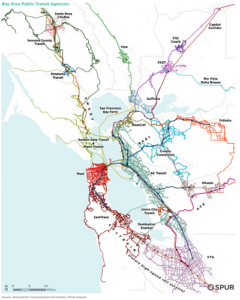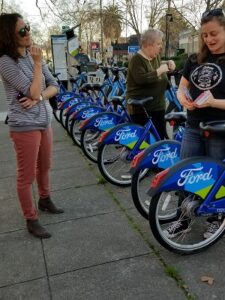With metro Detroit’s Regional Transit Authority once more debating whether to pursue funding at the ballot in 2018, some old questions have been revived: won’t it just be confusing to riders to have new rapid transit lines operating under a different banner than the existing local buses? Shouldn’t the existing local systems be merged or absorbed by the RTA before it creates any new services?

SPUR’s 2015 Seamless Transit report maps the Bay Area’s constellation of transit systems and outlines recommendations for continued improvement.
Well, no.
It turns out that an easy-to-use regional transit network doesn’t have to be a single system-just a relatively seamless system.
My family recently had a taste of this when we spent a week in the San Francisco Bay Area, visiting family and friends. When we arrived, our host handed us two house keys, and two Clipper Cards. While the Bay Area has almost two dozen overlapping local transit systems, these magical cards let us move around without having to worry about which system we were using-at least as long as we had money on them.

Left: the Bay Area’s refillable, durable, nearly magical token works across 20 connecting systems.
Right: my home transit agency’s flimsy single-system paper cards with finicky magnetic stripes.
BART subways? Tap the Clipper card at the turnstile. AC Transit (Oakland/Berkeley) buses? Tap the Clipper card at the farebox. Muni (City of San Francisco) bus? Tap. I could even unlock a bike from the Ford GoBike bikesharing stations with a tap of my card. No need to worry which system I was boarding, or if I had the right transfer for each system, or whether a day pass was more cost-effective than individual ride fares, or exact change, or whatever, just tap, and it’s all handled automagically.
With access to transit apps or Google Maps, planning a trip is similarly seamless, even with multiple transfers: take an AC Transit bus to the BART station, ride under the Bay, transfer to a Muni bus to reach a destination-all presented as easily as driving directions via Waze or similar, and with real-time updates about whether things were running on time. (This particular step relies on access to a smartphone or computer, which is a limitation I didn’t take an opportunity to navigate only via paper maps and posted signs.)
It’s these user-experience issues that make a difference, not the underlying legal structure of the agencies running the transit system. And they are strengths of the RTA that’s been created for metro Detroit. Rather than waiting on a consensus on the herculean task of merging transit systems, the RTA took on tasks to make the system more seamless: a single transit map, planning for a Clipper-like single-fare card system, planning for universal dial-a-ride dispatch, creating the RefleX regional express bus services.

Ford’s GoBike system is quick and easy to use–once you travel 3 time zones away from Dearborn.
As a transit rider, it’s these steps that would provide the most immediate benefit-I get once more excited what a (funded) RTA could do for southeast Michigan every time I visit a place that’s doing it right.
And, while the need for moving easily among multiple transit providers is less acute in Michigan’s other metro areas, the idea of seamless systems is still worth keeping in mind as we consider how to integrate new travel modes like ridehailing, bikeshare, and autonomous vehicles into our communities.